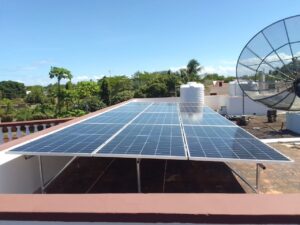What is the Efficiency for Solar Panels?

Solar panel efficiency is the amount of sunlight that falls on the surface of a solar panel and is converted into electricity. Solar panels are made of multiple silicon cells, which determine a panel’s overall efficiency rating, when combined. The structure and type of silicon crystal, generally monocrystalline or polycrystalline, electrical configuration and surrounding components of the solar cells all influence that number. Over the recent years, the panel efficiency has increased from 15% to 23%.
Monocrystalline vs. Polycrystalline Solar Panels
The two most common types of solar panels are monocrystalline and polycrystalline:
- Monocrystalline solar panels are made from the purest silicon and can achieve efficiencies of 22-27%. They are recognized by their dark, uniform color and rounded edges.
- Polycrystalline solar panels are slightly less efficient at 15-22%, but are often cheaper to produce. They have a distinctive blue, speckled appearance.
Why efficiency matters
Many people consider efficiency the most important aspect when selecting a solar panel. What matters most is the manufacturing quality, which is related to real-world performance, reliability, manufacturer’s service, and warranty conditions.
- Payback Period: Panel efficiency has increased beyond 20% reducing the payback time to less than 1.5 years in many locations. Increased efficiency also means a solar system generates more electricity over the solar panel’s average 20+ year life and repay the upfront cost sooner, meaning the return on investment (ROI) will be improved.
- Longer Life and Degradation: High-efficiency solar panels often use N-type silicon cells, which have an improved temperature coefficient and lower power degradation. These cells experience minimal light-induced degradation, around 0.25% per year, ensuring that over 25-30 years, the panels can retain 90% or more of their original capacity. The higher purity of N-type cells also means better performance due to fewer impurities and defects, thereby enhancing overall efficiency.
Related Article: How Reliable is Solar Power During Rainy Season in Kenya
Factors Affecting Solar Panel Efficiency
Several factors can impact the efficiency of solar panels:
- Solar Cell Structure and Composition: The photovoltaic materials used in the solar cells are the primary determinant of efficiency, with monocrystalline silicon being the most efficient.
- Temperature: Solar panels operate most efficiently between 59-95°F (15-35°C). Extreme temperatures, either very low or high, can reduce efficiency.
- Panel Age and Degradation: Solar panel efficiency decreases slowly over time, with a median degradation rate of around 0.5% per year.
- Maintenance: Keeping solar panels clean and free of debris can help maintain their efficiency.
The Impact of Efficiency on Solar Power Output
Solar panel efficiency is related to, but distinct from, the actual power output of a solar system. A higher efficiency panel will produce more electricity than a lower efficiency panel of the same size under the same sunlight conditions.
This makes high-efficiency panels particularly useful for homeowners with limited roof space, as they can maximize the power output from the available area.
Read More: Do Solar Panels Still Work on Cloudy Days
In conclusion, the efficiency of solar panels in 2024 typically ranges from 15% to 23% for residential systems, with more advanced panels reaching up to 40-50% efficiency. The type of solar cells, temperature, panel age, and maintenance all play a role in determining a solar panel’s efficiency and overall power output.
